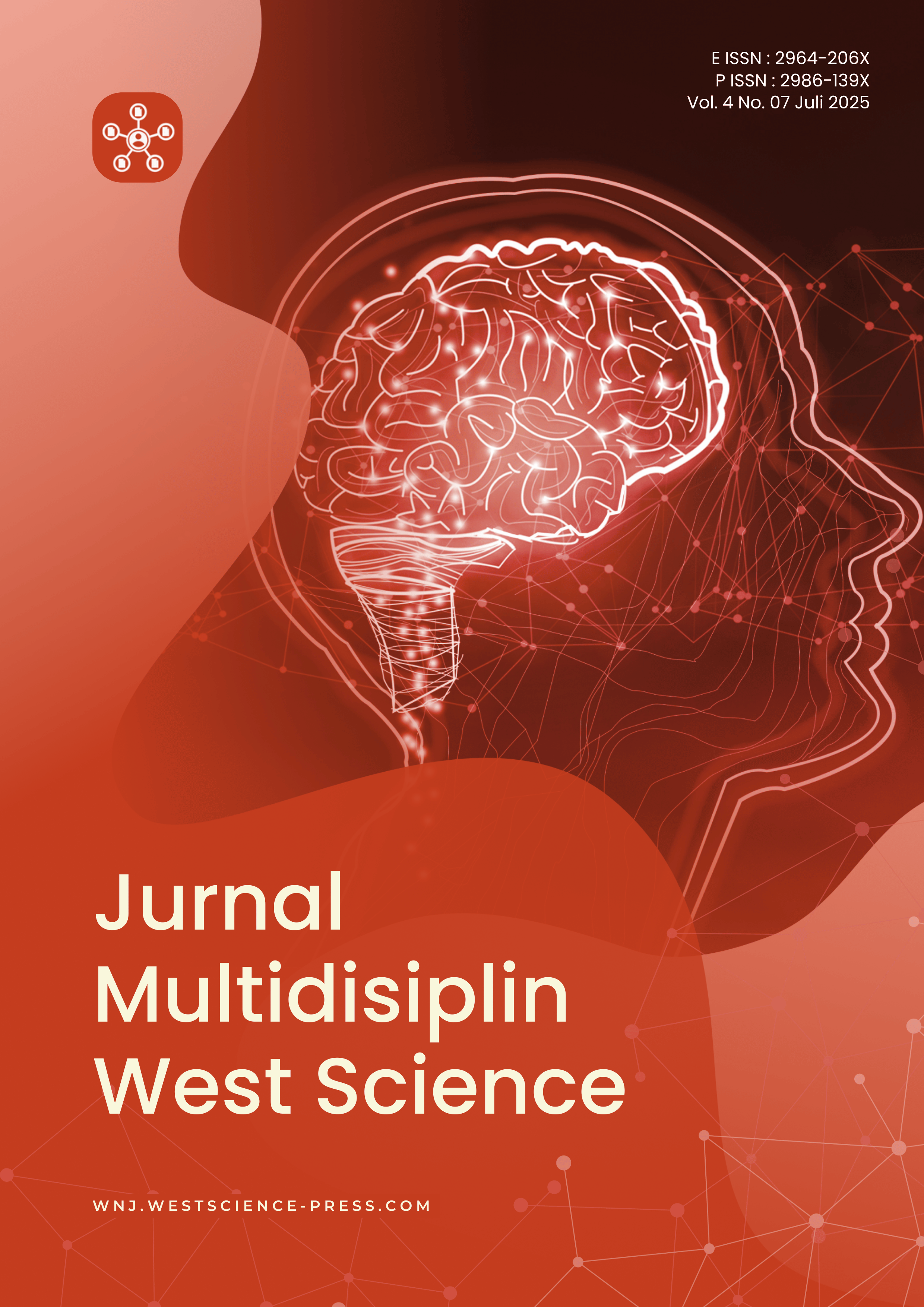Language as a Catalyst for Shaping Religious Identity and Political Ideology in the Era of Social Media
DOI:
https://doi.org/10.58812/jmws.v4i07.2439Kata Kunci:
Religious Identity, Political Ideology, Social Media, LanguageAbstrak
Beyond its traditional communicative purpose, language in the digital era serves as a strategic mechanism for constructing public opinion, affirming group solidarity, and circulating ideological content. However, its usage on social media platforms frequently contributes to increased social polarization. This study investigates the role of language in influencing religious identity and political ideology within digital discourse, emphasizing its dual capacity to foster both social cohesion and division. A Systematic Literature Review was conducted, comprising 44 peer-reviewed articles indexed in Scopus and Web of Science, published between 2021 and 2025. The analysis reveals a range of linguistic strategies, including symbolic representations, emotional rhetoric, and ideological framing, all of which play a significant role in constructing group identity and solidarity, while simultaneously intensifying societal fragmentation. These findings are interpreted through the lens of Critical Discourse Analysis and Framing Theory. The study highlights the urgent need for stronger regulatory frameworks addressing extremist content and calls for enhanced digital literacy to foster more responsible engagement in online discourse. Furthermore, it recommends future research to examine language use in non-English-speaking communities and to explore the long-term implications of digital communication on identity construction. This research contributes to a deeper understanding of the complex interplay between language, ideology, and identity in contemporary digital environments.
Referensi
A.A., K. (2022). Lingua-cultural strata of modern American social media: Precedent phenomena in anti-Trump discourse. Russian Journal of Linguistics, 26(3), 744–778. https://doi.org/DOI: 10.22363/2687-0088-27521
Abanoz, E. (2022). The Reactions to Muslim Identity Building through Social Media: User Comments on YouTube Street Interview Videos. In Religions (Vol. 13, Issue 6). https://doi.org/10.3390/rel13060498
Adebayo, & Akeem. (2022). Critical review of sustainable peace, mediative dialogue and social media. African Journal of Social Sciences and Humanities Research, 5(3), 28–43. https://doi.org/10.52589/ajsshr-34wcgpmn
Agarwal, R., & Jones, W. J. (2022). Social Media’s Role in the Changing Religious Landscape of Contemporary Bangkok. In Religions (Vol. 13, Issue 5). https://doi.org/10.3390/rel13050421
Agudelo, F. I. (2023). Faith Discourses in the Context of Racial Tension: Black Lives Matter and Its Counter-Narratives. Journal of Media and Religion, 22(1), 17–28. https://doi.org/10.1080/15348423.2023.2174322
Agudelo, F. I., & Olbrych, N. (2022). It’s Not How You Say It, It’s What You Say: Ambient Digital Racism and Racial Narratives on Twitter. Social Media + Society, 8(3), 20563051221122440. https://doi.org/10.1177/20563051221122441
Ait Hadi, K., Bendahan, M., & Chemaou, S. (2024). The Contribution of Religion to Protest Mobilization on Digital Social Networks. In Religions (Vol. 15, Issue 9). https://doi.org/10.3390/rel15091035
Alami Fariman, M., & Hakiminejad, A. (2024). Woman, Life, Freedom: Revolting space invaders in Iran. European Journal of Cultural Studies, 13675494241268100. https://doi.org/10.1177/13675494241268101
Alousque, I. N. (2024). The Linguistic Construction of Political Identity: the Case of Catalonia. Circulo de Linguistica Aplicada a La Comunicacion, 99(SE-Artículos), 223–232. https://doi.org/10.5209/clac.90058
Ansar, A., & Khaled, A. F. M. (2023). In search of a Rohingya digital diaspora: virtual togetherness, collective identities and political mobilisation. Humanities and Social Sciences Communications, 10(1), 61. https://doi.org/10.1057/s41599-023-01553-w
Aziz, A. (2022). Rohingya diaspora online: Mapping the spaces of visibility, resistance and transnational identity on social media. New Media & Society, 26(9), 5219–5239. https://doi.org/10.1177/14614448221132241
Barnidge, M. (2022). How geographic mobility contributes to exposure to political difference on social media platforms. Telematics and Informatics, 68, 101781. https://doi.org/https://doi.org/10.1016/j.tele.2022.101781
Bellina, A., Castellano, C., Pineau, P., Iannelli, G., & De Marzo, G. (2023). Effect of collaborative-filtering-based recommendation algorithms on opinion polarization. Physical Review E, 108(5), 54304. https://doi.org/10.1103/PhysRevE.108.054304
Booth, A., James, M.-S., Clowes, M., & Sutton, A. (2021). Systematic approaches to a successful literature review.
Borah, P., Keib, K., Trude, B., Binford, M., Irom, B., & Himelboim, I. (2022). “You are a disgrace and traitor to our country”: incivility against “The Squad” on Twitter. Internet Research, 32(5), 1646–1661. https://doi.org/10.1108/INTR-06-2021-0363
Bork-Hüffer, T. (2022). Digital media, friendships and migrants’ entangled and non-linear inclusion and exclusion. Urban Studies, 59(16), 3330–3346. https://doi.org/10.1177/00420980221111994
Boyd, R. L., & Markowitz, D. M. (2024). Verbal behavior and the future of social science. In American Psychologist (p. No Pagination Specified-No Pagination Specified). American Psychological Association. https://doi.org/10.1037/amp0001319
Bronnikov, E. (2023). Voicing Politics: How Language Shapes Public Opinion. Democratization, 30(8), 1628–1630. https://doi.org/10.1080/13510347.2023.2251005
Brown, O., Lowery, C., & Smith, L. G. E. (2022). How opposing ideological groups use online interactions to justify and mobilise collective action. European Journal of Social Psychology, 52(7), 1082–1110. https://doi.org/https://doi.org/10.1002/ejsp.2886
Chang, H.-C. H., Richardson, A., & Ferrara, E. (2022). #JusticeforGeorgeFloyd: How Instagram facilitated the 2020 Black Lives Matter protests. PLOS ONE, 17(12), e0277864. https://doi.org/10.1371/journal.pone.0277864
Chau, D. (2024). Linguistic ridicule and shifting indexical values on social media: The case of English in Hong Kong. Language in Society, 1–24. https://doi.org/DOI: 10.1017/S0047404524000691
Chen, A., Chen, K., Zhang, J., Meng, J., & Shen, C. (2023). When national identity meets conspiracies: the contagion of national identity language in public engagement and discourse about COVID-19 conspiracy theories. Journal of Computer-Mediated Communication, 28(1), zmac034. https://doi.org/10.1093/jcmc/zmac034
Chiluwa, I. (n.d.). Investigating the language of conflict and peace in critical discourse studies. Critical Discourse Studies, 1–6. https://doi.org/10.1080/17405904.2024.2331160
Chin, C., & Levey, G. B. (2023). Recognition as acknowledgement: symbolic politics in multicultural democracies. Ethnic and Racial Studies, 46(3), 451–474. https://doi.org/10.1080/01419870.2022.2075233
Christiansen, M. S. (n.d.). “Pochas sin identidad”: Raciolinguistic ideologies in the construction of mexicanidad in online spaces. International Multilingual Research Journal, 1–18. https://doi.org/10.1080/19313152.2024.2342726
Civila, S., & Lugo-Ocando, J. A. (n.d.). News Framing and Platform Affordances in Social Media. Journalism Practice, 1–23. https://doi.org/10.1080/17512786.2024.2319249
Dekeyser, D., & Roose, H. (2022). What Makes Populist Messages Persuasive? Experimental Evidence for How Emotions and Issue Characteristics Moderate Populist Framing Effects. Communication Research, 50(6), 773–797. https://doi.org/10.1177/00936502221127482
Demaj, U. (2022). Symbolic identity building, ethnic nationalism and the linguistic reconfiguration of the urban spaces of the capital of Pristina, Kosovo. Ethnicities, 23(3), 500–522. https://doi.org/10.1177/14687968221097810
Dhami, S., Wei, M., & Mamidi, P. (2024). Religious identity, trust, reciprocity, and prosociality: Theory and evidence. Journal of Development Economics, 166, 103192. https://doi.org/https://doi.org/10.1016/j.jdeveco.2023.103192
Dodlek, I. (2024). Values in Narratives: Religious Education as an Exercise in Emotional Rationality. In Religions (Vol. 15, Issue 10). https://doi.org/10.3390/rel15101283
Dooly, M., & Darvin, R. (2022). Intercultural communicative competence in the digital age: critical digital literacy and inquiry-based pedagogy. Language and Intercultural Communication, 22(3), 354–366. https://doi.org/10.1080/14708477.2022.2063304
Eady, G., Bonneau, R., Tucker, J. A., & Nagler, J. (2024). News Sharing on Social Media: Mapping the Ideology of News Media, Politicians, and the Mass Public. Political Analysis, 1–18. https://doi.org/DOI: 10.1017/pan.2024.19
Fabbri, G. (2022). Intersectional activism on social media: Anti-racist and feminist strategies in the digital space. Journal of Postcolonial Writing, 58(5), 713–728. https://doi.org/10.1080/17449855.2022.2111223
Garello, S. (2024). Metaphor as a “Matter of Thought”: Conceptual Metaphor Theory BT - The Enigma of Metaphor: Philosophy, Pragmatics, Cognitive Science (S. Garello (ed.); pp. 65–100). Springer Nature Switzerland. https://doi.org/10.1007/978-3-031-56866-4_3
Gordon, C., & Tannen, D. (2023). Framing and related concepts in interactional sociolinguistics. Discourse Studies, 25(2), 237–246. https://doi.org/10.1177/14614456231155073
Hackenburg, K., & Margetts, H. (2024). Evaluating the persuasive influence of political microtargeting with large language models. Proceedings of the National Academy of Sciences, 121(24), e2403116121. https://doi.org/10.1073/pnas.2403116121
Jackson, J., Fine, A., Bradford, B., & Trinkner, R. (2023). Social identity and support for defunding the police in the aftermath of George Floyd’s murder. Group Processes & Intergroup Relations, 26(4), 833–858. https://doi.org/10.1177/13684302221128230
Jaff, D. (2023). The surge of spreading harmful information through digital technologies: a distressing reality in complex humanitarian emergencies. The Lancet Global Health, 11(6), e821–e822. https://doi.org/10.1016/S2214-109X(23)00207-3
Jamil, S. (2022). Postulating the Post-Arab Spring Dynamics of Social Media & Digital Journalism in the Middle East. Digital Journalism, 10(7), 1257–1261. https://doi.org/10.1080/21670811.2022.2040040
Kim, S. J., Villanueva, I. I., & Chen, K. (2024). Going Beyond Affective Polarization: How Emotions and Identities are Used in Anti-Vaccination TikTok Videos. Political Communication, 41(4), 588–607. https://doi.org/10.1080/10584609.2023.2243852
Kim, T. (2023). Violent political rhetoric on Twitter. Political Science Research and Methods, 11(4), 673–695. https://doi.org/DOI: 10.1017/psrm.2022.12
Klinger, U., Koc-Michalska, K., & Russmann, U. (2023). Are Campaigns Getting Uglier, and Who Is to Blame? Negativity, Dramatization and Populism on Facebook in the 2014 and 2019 EP Election Campaigns. Political Communication, 40(3), 263–282. https://doi.org/10.1080/10584609.2022.2133198
Kwuelum, C. (2024). Navigating the Complexities of Inter-Religious Peacebuilding: Implications for Theory and Practice. In Religions (Vol. 15, Issue 10). https://doi.org/10.3390/rel15101201
Mayor, E., & Bietti, L. M. (2024). Language use on Twitter reflects social structure and social disparities. Heliyon, 10(2). https://doi.org/10.1016/j.heliyon.2023.e23528
McLean, N., Capstick, G., & Passarini, B. (2024). Identity work in conservative political discourse: a cross-cultural comparison. Language and Intercultural Communication, 24(6), 558–571. https://doi.org/10.1080/14708477.2023.2269399
Mehmet, M. I., & D’Alessandro, S. (2022). More than words can say: a multimodal approach to understanding meaning and sentiment in social media. Journal of Marketing Management, 38(13–14), 1461–1493. https://doi.org/10.1080/0267257X.2022.2105933
Michail, E. (2024). The distorting effects of the for-or-against binary in the representation of European refugee hosting societies in 2015–6. Journal of Refugee Studies, feae078. https://doi.org/10.1093/jrs/feae078
Mishol-Shauli, N., & Golan, O. (2022). Smartphone Religious Networking: Negotiating Contested Identities within a Pious Community over WhatsApp. In Religions (Vol. 13, Issue 11). https://doi.org/10.3390/rel13111034
Moore, R. C., & Hancock, J. T. (2022). A digital media literacy intervention for older adults improves resilience to fake news. Scientific Reports, 12(1), 6008. https://doi.org/10.1038/s41598-022-08437-0
Müller, P., Harrendorf, S., & Mischler, A. (2022). Linguistic Radicalisation of Right-Wing and Salafi Jihadist Groups in Social Media: a Corpus-Driven Lexicometric Analysis. European Journal on Criminal Policy and Research, 28(2), 203–244. https://doi.org/10.1007/s10610-022-09509-7
O’Rourke, B., & Dayán-Fernández, A. (2024). Discourses of solidarity and resistance in alternative linguistic spaces: Galician improvised poetry as linguistic collective action. Journal of Sociolinguistics, 28(5), 79–98. https://doi.org/https://doi.org/10.1111/josl.12675
Orkibi, E. (2022). Self-othering to power: vilification, ridicule and moral claims in the Israeli right ‘underdog’ discourse. Journal of Multicultural Discourses, 17(2), 158–172. https://doi.org/10.1080/17447143.2022.2079649
Page, M. J., McKenzie, J. E., Bossuyt, P. M., Boutron, I., Hoffmann, T. C., Mulrow, C. D., Shamseer, L., Tetzlaff, J. M., Akl, E. A., Brennan, S. E., Chou, R., Glanville, J., Grimshaw, J. M., Hróbjartsson, A., Lalu, M. M., Li, T., Loder, E. W., Mayo-Wilson, E., McDonald, S., … Moher, D. (2021). The PRISMA 2020 statement: an updated guideline for reporting systematic reviews. BMJ, 372, n71. https://doi.org/10.1136/bmj.n71
Panarari, M., & Gili, G. (2024). Spiritual Technologies: The Religious Symbolism of the Digital Universe. In Religions (Vol. 15, Issue 11). https://doi.org/10.3390/rel15111320
Peker, E. (2022). Finding Religion: Immigration and the Populist (Re)Discovery of Christian Heritage in Western and Northern Europe. In Religions (Vol. 13, Issue 2). https://doi.org/10.3390/rel13020158
Peralta, A. F., Ramaciotti, P., Kertész, J., & Iñiguez, G. (2024). Multidimensional political polarization in online social networks. Physical Review Research, 6(1), 13170. https://doi.org/10.1103/PhysRevResearch.6.013170
Poorthuis, A., Chen, Q., & Zook, M. (2024). A nationwide dataset of de-identified activity spaces derived from geotagged social media data. Environment and Planning B: Urban Analytics and City Science, 51(9), 2264–2275. https://doi.org/10.1177/23998083241264051
Reicher, S., Hopkins, N., Stevenson, C., Pandey, K., Shankar, S., & Tewari, S. (2021). Identity enactment as collective accomplishment: Religious identity enactment at home and at a festival. British Journal of Social Psychology, 60(2), 678–699. https://doi.org/https://doi.org/10.1111/bjso.12415
Russo, R., Blikstein, P., & Literat, I. (2024). Twisted knowledge construction on X/Twitter: an analysis of constructivist sensemaking on social media leading to political radicalization. Information and Learning Sciences, 125(9), 693–719. https://doi.org/10.1108/ILS-12-2023-0210
Senbel, S., Seigel, C., & Bryan, E. (2022). Religious Violence and Twitter: Networks of Knowledge, Empathy and Fascination. In Religions (Vol. 13, Issue 3). https://doi.org/10.3390/rel13030245
Sheets, P., Rowling, C. M., Gilmore, J., & Melcher, N. (2023). Us and Them: The Role of Group Identity in Explaining Cultural Resonance and Framing Effects. Mass Communication and Society, 26(2), 252–274. https://doi.org/10.1080/15205436.2022.2026399
Song, W., Pang, B., Wang, Z., Xu, Y., Liu, Z., & Tan, M. (2024). Differentiated secularism: discourse shaping of immigrants from different religious backgrounds in the French media. Humanities and Social Sciences Communications, 11(1), 893. https://doi.org/10.1057/s41599-024-03390-x
Sulfikar, A., Kerkhof, P., & Tanis, M. (2023). Tweeting for Religion: How Indonesian Islamic Fundamentalist Organizations Use Twitter. Journal of Media and Religion, 22(1), 1–16. https://doi.org/10.1080/15348423.2023.2174324
Szabó, G., & Lipiński, A. (2024). Sympathy With Ukraine (Or Not So Much)! Emotion-Based Solidarity in the Political Communication of the Polish and Hungarian Prime Ministers. American Behavioral Scientist, 00027642241240357. https://doi.org/10.1177/00027642241240357
Vico, S. (2024). Social Media, Stereotypes, and the Acknowledgement of War Crimes. Journal of Intervention and Statebuilding, 18(5), 620–637. https://doi.org/10.1080/17502977.2024.2316747
Walker, B. (2024). Words and Attitudes of the Heart: The Emotional Content of Christian Nationalist Communications. In Religions (Vol. 15, Issue 7). https://doi.org/10.3390/rel15070825
Widian, R., Satya, P. A. N. I. P., & Yazid, S. (2023). Religion in Indonesia’s Elections: An Implementation of a Populist Strategy? Politics and Religion, 16(2), 351–373. https://doi.org/DOI: 10.1017/S1755048321000195
Widmann, T. (2022). Fear, Hope, and COVID-19: Emotional Elite Rhetoric and Its Impact on the Public During the First Wave of the COVID-19 Pandemic. Political Psychology, 43(5), 827–850. https://doi.org/https://doi.org/10.1111/pops.12831
Wijayanto, Berenschot, W., Sastramidjaja, Y., & Ruijgrok, K. (2024). The Infrastructure of Domestic Influence Operations: Cyber Troops and Public Opinion Manipulation Through Social Media in Indonesia. The International Journal of Press/Politics, 19401612241297830. https://doi.org/10.1177/19401612241297832
Yilmaz, I., Demir, M., & Shipoli, E. (2023). Authoritarian Use of Religion to Delegitimize and Securitize the Opposition. In Religions (Vol. 14, Issue 5). https://doi.org/10.3390/rel14050596
Zhang, C. (2022). Contested disaster nationalism in the digital age: Emotional registers and geopolitical imaginaries in COVID-19 narratives on Chinese social media. Review of International Studies, 48(2), 219–242. https://doi.org/DOI: 10.1017/S0260210522000018
Unduhan
Dimensions
Diterbitkan
Terbitan
Bagian
Lisensi
Hak Cipta (c) 2025 Ahmad Zaki Munibi

Artikel ini berlisensiCreative Commons Attribution-ShareAlike 4.0 International License.






















 Instagram
Instagram 